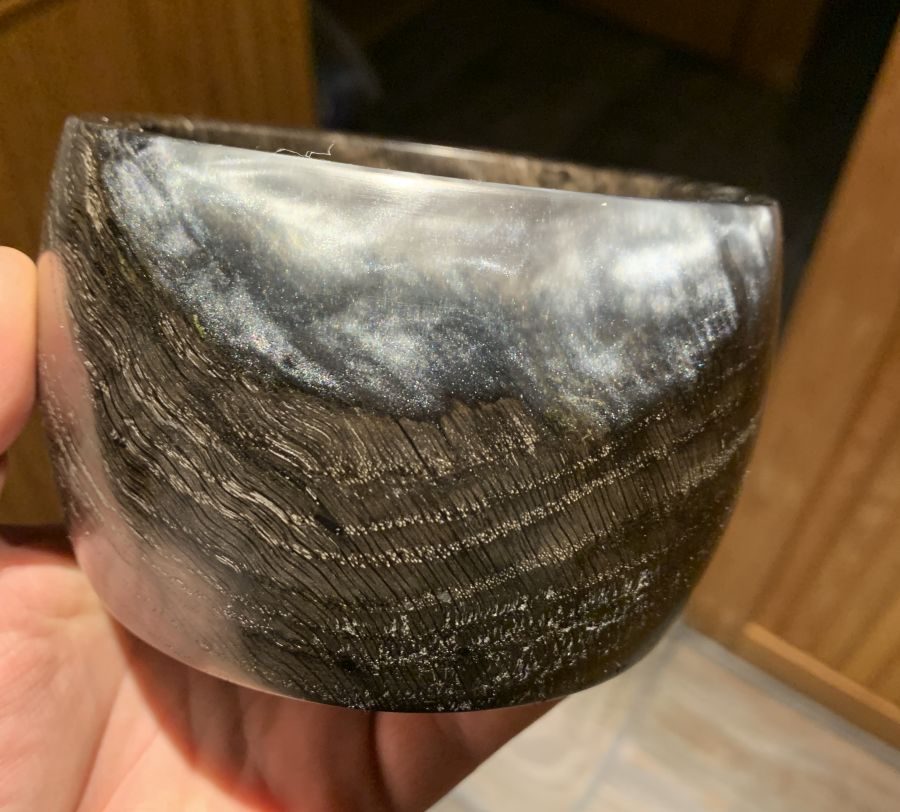Right now I have more pretty stuff that I’ve made than I have time to photograph well and post/discuss about.
All of this is done in the context of me feeling worried/bad that I have not gotten my forge back up in operation. It’s driving me a bit nuts in fact. Come spring I am going to maybe take a week off blogging and just kick ass 9-5 and get everything done. I need to stop picking up easy work and going after it – but to be honest in these weird times, it’s comforting to get lost in the sound of the chisel and the lathe, and I can create something satisfying in an hour. [Let me say here for the record: if any of you wish to learn some basic bowl-turning, and want to come visit the studio, contact me. Bear in mind it’s dangerous.]
I am naming this ridgeline, because of the way the shredded wood looks. This is an experiment that turned out pretty well. I took the blank and vacuum soaked it in resin. It’s bog oak (of course!) about 4,000 years old. It has exceptional grain and because of all the resin in the wood, it’s heavy and strong.

I don’t understand why bog oak seems so burly compared to regular oak. I think it may be because of the age of the trees (these were trees that grew old) and perhaps the parts of the tree that survive the long soak are the tough parts. I don’t know.
Bog oak is expensive. Unfortunately. And I feel a weird sense of responsibility putting a chisel to something that is older than christendom. I want to do it justice.

To vacuum soak the resin, I put the piece of bog oak in a plastic bucket, added the resin to cover the chunk of oak, and vacuumed the air out. The next day I dropped the vacuum and let the piece sit for 4 or 5 hours, then set the bucket on the radiator to cure. It’s a simple process and I deem it effective.

Resin soaked bog oak is really tough stuff. I am pretty sure that with my carbide scraper I could get the bowl wall to less than half the thickness you see here. That would make the bowl perhaps a bit more elegant. But then I’d lose the cloudy effect in the resin. Decisions, decisions, decisions!
The spin-down is so exciting to me. As you sand and polish, you can see the wood getting shinier but the details of the wood are imperceptible because of how fast it’s spinning. I’ve taken to doing the sanding-through-polishing as a single step, because I do so enjoy the magic moment when the lathe stops spinning, and I can see my work for the first time.
When I sand these things I start with 40 grit, then when it feels smooth I go to 80, 120, 240, 400, 800, and then steel wool and a paper towel loaded with “yorkshire grit”, which is beeswax and linseed oil melted and mixed with diatomaceous earth. The diatoms break down as they polish the wood, and when the whole thing is done, you wipe the grit off with a paper towel and then oil the wood with linseed oil.

Oh, that looks nice! I’ve watched* a whole lot of bowls and other items being turned and it’s always a treat seeing that last spin finished and showing off the final products.
*Well, pretty much the before and after shots. Some of these videos are really long so I skip the stuff I don’t want to see. I do the same with restoration videos.
Another beautiful piece!
“Hope” got moved today to a more central place in its sunny windowsill and was rotated 90 degrees so I can enjoy the effect of daylight moving through the resin from a different angle. Next month I’ll rotate it again.
That is one gorgeous bowl! Yeah that’s pretty cool as it gradually stops spinning to see the details emerge. I bet the tactile sensation of feeling it so smooth when it didn’t start out that way is also wonderful.
Origin of the beveled-rim bowl
Ooh, that is lovely
A lot of new oak would be plantation timber, right? So they are trimming branches and shaping the tree to get them to grow quick and straight, which leads to boring grain. While the bog oak was uncultivated, so it’s growing with more branches and complex bits. Plus it would be probably be older when it got knocked down in a flood.
It turned out beautifully! The crossgrain (?) and wavy grain patterns have such depth.
I don’t know if being impregnated with tannins and dissolved minerals would make the oak heavier. It seems logical that it would weigh more if it was partially permineralized.
Oak is fairly heavy wood in any case, but old growth oak is incredibly dense hard wood due to the slow growth and age of ancient trees. I marvel at the tight grain of the old growth lumber that’s visible in my unfinished attic.
Oh, it looks like frost
Interesting grain. The resin really brings it out. It’s nice that a tree fragment that old and full of history can become something splendid again.
Ming